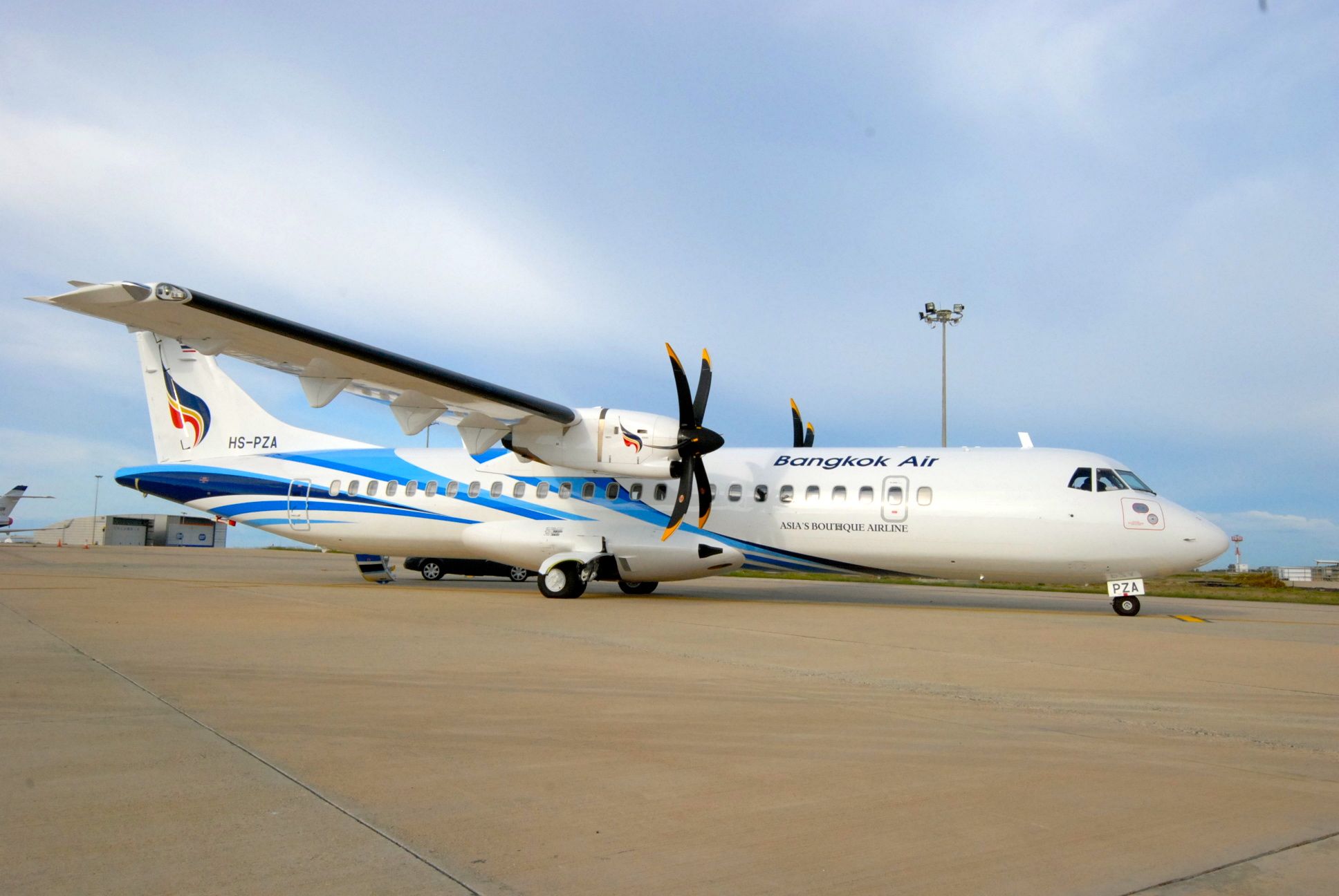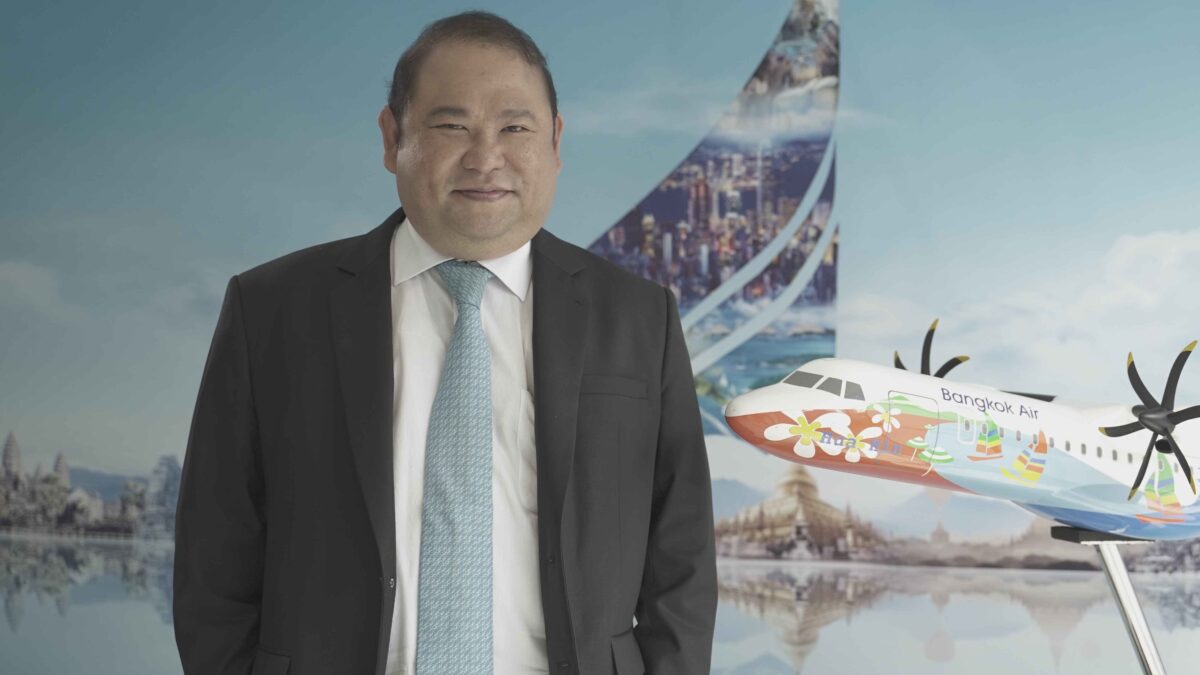INTERVIEW: Bangkok Airways’ Puttipong Prasarttong-Osoth On How The Carrier Is Grappling With Turbulence And Headwinds Caused By Omicron
Note: Thai language version of article is lower down หมายเหตุ: บทความภาษาไทยอยู่ด้านล่าง
While the coronavirus has already left airlines in the lurch, the rapid spread of the highly transmissible new variant Omicron appears to add insult to injury.
Thailand-registered carriers like Bangkok Airways, which just recently began to see some recovery in traffic due to Thailand’s border re-opening and easing of local Covid restrictions, are facing a major new cause of concern that may dull the prospects of their revival.
In a blow to the recovery of the travel sector, Thailand on 21 December abruptly scrapped the ‘test & go’ waiver scheme – that allowed fully vaccinated travellers from low-risk countries to enter the kingdom without quarantine – and restored mandatory isolation to keep the highly mutated coronavirus at bay.
The ‘temporary’ suspension lasts from 21 December to January 4, though visitors whose entry applications -numbering 90,000 – which were previously approved are allowed to enter Thailand as planned.
Those arriving in Phuket, vaccinated and tested, under the Phuket ‘sandbox’ programme, first introduced on 1 July, are allowed free movement on the island for seven days before being allowed to venture to other areas in Thailand.
Puttipong Prasarttong-Osoth, president of Bangkok Airways, says Omicron is a daunting new challenge to the aviation industry and to Bangkok Airways’ turnaround bid.
“As witnessed in the past, when there is an outbreak, air travel will be among the first activities subject to control [restrictions], even though airlines apply high health and safety standards,” he tells the Smart Aviation APAC.
He says if the Omicron in Thailand gets out of hand and lockdowns are re-imposed then it will be necessary for the Thai government to provide ‘genuine’ relief to Thailand’s battered aviation businesses.
“But best of all [scenarios] is not to see a wide spread of Omicron and no more lockdowns,” Puttipong adds.
Earlier attempts by the Airlines Association of Thailand (AAT), where Puttipong serves as president, to seek a five billion baht (US$152 million) soft loan from the Thai government, have gone astray. The government declined to provide the soft loans, arguing that many businesses have been adversely affected by Covid, not just the airline industry.
With Covid challenges aplenty, Bangkok Airways is seeking new revenue streams while working to reduce the businesses’ overall cash burn.
Chief among the initiatives are further redundancies, downsizing the fleet, restoring routes and boosting load factors in an effort to move into the black, says Puttipong.
Redundancy
Since last year, the airline has shed nearly a third of its 3,000-strong workforce by means of voluntary separation, contract expiration and sabbatical leave.
Puttipong hints that there will be further staff cuts in 2022, but the number is likely to be small, adding that those who are on the ‘leave-without-pay’ can quickly report back to work when needed.
Fleet downsize
Bangkok Airways will be trimming its fleet from 35 aircraft at the end of 2021 to 30 in 2022 to match traffic demand, says Puttipong. The airline is due to phase out an Airbus A319 and two ATR72-500 turboprops from its fleet at the end of 2021.

The airline says in 2022 it is due to return five A320s to lessors upon the end of the contract. As a result, its fleet in 2022 will comprise four A320s, 13 A319s and 13 ATR72-600s.
Puttipong says an A320 incurs annual lease and maintenance costs of US$6-8 million, so taking that out represents a significant cost reduction.
Restoring routes
Despite Omicron, Bangkok Airways remains on track to restore domestic and international routes.
The Thai Government decided on 1 November to reopen Thailand to vaccinated arrivals from 63 countries and territories. Bangkok Airways operates domestic and short-haul flights but relies heavily on international tourists from places far away such as Europe and North America. It has interline agreements and codeshares, for example, with European and North American carriers, so when passengers from those airlines arrive in Bangkok, they connect to Bangkok Airways to travel around Thailand and Southeast Asia.
Bangkok Airways’ route reinstatement comes in three groups.
Group A consists of three routes: Bangkok-Phnom Penh, Phuket-U-tapao and Samui-U-tapao; which all started on 1 December.
Group B: Samui-Hong Kong, Samui-Chiang Mai and Bangkok-Krabi; starting April-October 2022.
Group C: Chiang Mai-Phuket, Chiang Mai-Krabi, Samui-Krabi, Bangkok-Luang Prabang, Bangkok-Yangon, Bangkok-Da Nang, Bangkok-Maldives and Bangkok – Siem Reap; commencing end of October 2022.
These are in addition to routes, mostly domestic, the airline restored at the end of October: Bangkok-Samui, Bangkok-Chiang Mai, Bangkok-Phuket, Bangkok-Lampang, Bangkok-Sukhothai, Bangkok-Trat, Samui-Phuket, Phuket-Hat Yai and Samui-Singapore.
Prospects
Puttipong is cautiously optimistic about the prospect of the airline getting back on its feet soon. This is despite the fact Bangkok Airways already posted losses of 8.44 billion baht (US$250 million) in the first nine months of 2021.
Bearing no major obstacles impeding international arrivals, which is Bangkok Airways’ core passenger base, he says he expects to see passenger numbers returning to 30-50% of pre-Covid levels in 2022, 60-80% in 2023 and nearing 2019-levels in 2024.
Turning black
But he says it is an uphill task to turn the airline’s balance sheet around as soon as in 2022 as wished.
“It’s tough to become profitable in 2022 with fixed costs remaining burdensome and more variable costs piling on the pressure,” he says. “[But] the balance sheet should see some improvement going forward.”
He says 2021 will go down as the worst financial year ever for the 53-year-old airline; far worse than 2020 when Covid first began to decimate the aviation industry.
Net losses in the first nine months of 2021 were 72% higher than the 4.89 billion baht loss recorded in the same period last year.
But he says the incremental losses were due largely to the termination of the airline’s 30-year lease agreement with the Samui Airport Property Fund (SPF) in the third quarter of 2021 when an amount of 5.4 billion baht was booked.
Bangkok Airways earlier in 2021 agreed to pay SPF 18.1 billion baht for 15 and a half years of remaining leasehold life.
Puttipong says scrapping the SPF accord represents a long-term cost saving for the airline because otherwise it would need to contribute more than one billion baht a year to the fund.
The airline saw significant performance deteriorations in the first nine months of 2021.
Passenger revenues slumped to only 543 million baht compared with 4.99 billion baht in the same period of the previous year. Total passengers carried plunged to just 270,000 from 1.5 million in the previous period. Load factors were down to 55.2% from 62.4% earlier. Flight frequencies numbered 4,800, down sharply from over 20,000 previously.
Bangkok Airways says it expects 2021’s full year results to show it had: 400,000 passengers, flights totaling 8,272, a load factor of 62% and 757 million baht in passenger revenue.
Captions:
- Bangkok Airways president Puttipong Prasarttong-Osoth (credit: ATR)
- ATR 72-600 is the only type of turboprop in Bangkok Airways’ fleet (credit: Bangkok Airways).
สัมภาษณ์: พุฒิพงศ์ ปราสาททองโอสถ กรรมการผู้อำนวยการใหญ่ บริษัท การบินกรุงเทพ จำกัด (มหาชน) กับการต้องต่อสู้ของสายการบินบางกอกแอร์เวย์สกับความปั่นป่วน และลมปะทะที่เกิดจากโอไมครอนอย่างไร
บุญส่ง โฆษิต 27 ธ.ค. 2564
เวลาอ่าน 6 นาที
ในขณะที่วิกฤติโควิดได้ทำให้สายการบินตกต่ำเป็นอย่างยิ่งไปแล้ว การแพร่กระจายอย่างรวดเร็วของไวรัสสายพันธุ์ใหม่ โอไมครอน ที่แพร่เชื้อได้อย่างรวดเร็ว ดูเหมือนว่าจะสร้างการบาดเจ็บเพิ่มเติมให้กับสายการบินต่างๆ
สายการบินที่จดทะเบียนในประเทศไทย เช่น บางกอกแอร์เวย์ส ซึ่งเพิ่งเริ่มเห็นการฟื้นตัวของการจราจรเนื่องจากการเปิดพรมแดนของประเทศไทยอีกครั้ง และการผ่อนคลายข้อจำกัดด้านโควิด กำลังเผชิญกับความกังวลใหม่ที่อาจทำให้โอกาสในการฟื้นตัวลดลง
อุปสรรคในการฟื้นตัวของภาคการเดินทางประเทศไทยได้เริ่มปรากฏขึ้นเมื่อวันที่ 21 ธันวาคมจากการที่รัฐบาลไทยได้ยกเลิกโครงการยกเว้น.”Test & Go” อย่างกะทันหัน ซึ่งอนุญาตให้นักเดินทางที่ได้รับวัคซีนครบถ้วนแล้วจากประเทศที่มีความเสี่ยงต่ำสามารถเข้าราชอาณาจักรได้โดยไม่มีการกักกัน และกลับมาใช้มาตรการบังคับการแยกตัวเพื่อป้องกันการแพร่ของเชื้อโคโรนาที่กลายพันธุ์อย่างมาก
การระงับแบบ “ชั่วคราว” นี้มีผลตั้งแต่วันที่ 21 ธันวาคม ถึง 4 มกราคม แม้ว่าผู้ผู้ที่ได้รับอนุญาตเข้าประเทศแล้วก่อนหน้า จำนวน 90,000 คนจะยังสามารถเดินทางมาประเทศไทยได้ตามแผนที่วางไว้
อย่างไรก็ดี ผู้ที่เดินทางมาโดยได้รับวัคซีน และผ่านการตรวจสอบการติดเชื้อแล้ว ภายใต้โครงการ “ภูเก็ตแซนด์บ็อกซ์” ซึ่งเปิดตัวครั้งแรกเมื่อวันที่ 1 กรกฎาคม จะยังคงสามารถเคลื่อนย้ายบนเกาะภูเก็ตได้เป็นเวลาเจ็ดวัน ก่อนจะได้รับอนุญาตให้เดินทางไปยังพื้นที่อื่นๆ ในประเทศไทย
พุฒิพงศ์ ปราสาททองโอสถ กรรมการผู้อำนวยการใหญ่ บริษัท การบินกรุงเทพ จำกัด (มหาชน) กล่าวว่าโอไมครอนเป็นความท้าทายครั้งใหม่ที่น่ากลัวสำหรับอุตสาหกรรมการบิน และกับการฟื้นฟูธุรกิจของบางกอกแอร์เวย์ส
“ดังที่เคยประสบมาในอดีต เมื่อมีการระบาด การเดินทางทางอากาศจะเป็นหนึ่งในกิจกรรมแรกๆ ที่อยู่ภายใต้การควบคุม [ข้อจำกัด] แม้ว่าสายการบินจะใช้มาตรฐานด้านสุขภาพและความปลอดภัยระดับสูงก็ตาม” เขาบอกกับ Smart Aviation APAC
เขากล่าวว่าหากโอไมครอนแพร่กระจายเกินความควบคุมได้ในประเทศไทย และมีการบังคับใช้มาตรการล็อกดาวน์อีกครั้ง รัฐบาลไทยจะต้องให้ความช่วยเหลือ “อย่างแท้จริง” แก่ธุรกิจการบินของไทยที่ประสบปัญหา
“แต่สิ่งที่ดีที่สุด คือไม่เห็นการแพร่กระจายของโอไมครอนในวงกว้าง และไม่มีการล็อกดาวน์อีกต่อไป” พุฒิพงศ์กล่าวเสริม
ความพยายามก่อนหน้านี้ของสมาคมการบินแห่งประเทศไทย (AAT) ซึ่งนายพุฒิพงศ์ทำหน้าที่เป็นประธาน ในการขอเงินกู้ดอกเบี้ยต่ำ (ซอฟท์โลน) จำนวน 5 พันล้านบาท จากรัฐบาลไทยไม่ได้รับการตอบสนอง โดยรัฐบาลอ้างว่าธุรกิจจำนวนมากก็ได้รับผลกระทบจากโควิดเช่นกัน ไม่ใช่แค่อุตสาหกรรมการบินเท่านั้น
ภายใต้ความท้าทายจากโควิดอย่างมากมาย บางกอกแอร์เวย์สจึงแสวงหาช่องทางรายได้ใหม่ พร้อมๆ กับลดการใช้จ่ายเงินสดโดยรวมของธุรกิจ
ในบรรดาความคิดริเริ่มหลักต่างๆ ได้แก่ การลดบุคลากร ฝูงบิน ฟื้นฟูเส้นทาง และเพิ่มอัตราการบรรทุกผู้โดยสาร (Load Factor) ในความพยายามที่จะทำให้กิจการกลับมามีผลกำไร พุฒิพงศ์กล่าว
การลดบุคลากร
นับตั้งแต่ปีที่แล้ว สายการบินได้ปลดพนักงานเกือบ หนึ่งในสาม ของจำนวนพนักงานทั้งหมด 3,000 คนออก โดยการสมัครใจลาออก หมดสัญญาจ้าง และลาพักร้อนโดยไม่ได้ค่าจ้าง (leave-without-pay)
พุฒิพงศ์บอกเป็นนัยว่าจะมีการปรับลดพนักงานอีกในปี 2565 แต่จำนวนนี้น่าจะมีน้อย โดยเสริมว่าผู้ที่อยู่ในสถานะ “พักงานโดยไม่ได้ค่าจ้าง” สามารถรายงานกลับไปทำงานได้อย่างรวดเร็วเมื่อจำเป็น
ลดขนาดฝูงบิน
บางกอกแอร์เวย์สกำลังลดฝูงบินจาก 35 ลำภายในสิ้นปี 2564 ให้เป็น 30 ลำในปี 2565 เพื่อให้สอดคล้องกับความต้องการด้านการเดินทางทางอากาศ พุฒิพงศ์กล่าว
สายการบินมีกำหนดปลดเครื่องบินไอพ่นแอร์บัส A319 หนึ่งลำ และเครื่องบินใบพัดรุ่น ATR72-500 จำนวน สองลำจากฝูงบินในช่วงปลายปี 2564
ในปี 2022 จะมีการคืนเครื่องบินไอพ่น A320 จำนวนห้าลำให้กับผู้ให้เช่าเมื่อสิ้นสุดสัญญา เป็นผลให้ฝูงบินในปี 2565 จะประกอบด้วยเครื่องบิน A320 สี่ลำ, A319 13 ลำและ ATR72-600 13 ลำ
พุฒิพงศ์กล่าวว่าเครื่องบิน A320 นั้นต้องเสียค่าเช่าและค่าบำรุงรักษารายปีอยู่ที่ 6-8 ล้านดอลลาร์สหรัฐ ดังนั้นการปลดประจำการจึงช่วยลดต้นทุนได้อย่างมาก
ฟื้นฟูเส้นทางบิน
แม้ว่าโอไมครอนกำลังเริ่มระบาดอย่างรวดเร็ว แต่บางกอกแอร์เวย์สก็ยังคงเดินหน้าฟื้นฟูเส้นทางทั้งในและต่างประเทศอย่างต่อเนื่อง
รัฐบาลไทยได้ตัดสินใจเปิดประเทศไทยอีกครั้งใน วันที่ 1 พฤศจิกายน ให้ให้นักเดินทางที่ได้รับวัคซีนแล้วจาก 63 ประเทศและดินแดนเข้ามาได้
บางกอกแอร์เวย์สให้บริการเที่ยวบินภายในประเทศและเที่ยวบินระยะสั้น แต่ต้องพึ่งพานักท่องเที่ยวจากแดนไกล เช่น จากยุโรปและอเมริกาเหนือ เป็นอย่างมาก
บางกอกแอร์เวย์สมีข้อตกลงระหว่างสาย (interline agreements) และรหัสร่วมกัน (codeshares) เช่น กับสายการบินในยุโรปและอเมริกาเหนือ ดังนั้นเมื่อผู้โดยสารจากสายการบินเหล่านั้นมาถึงกรุงเทพฯ พวกเขาจะเชื่อมต่อกับบางกอกแอร์เวย์ส เพื่อเดินทางทั่วไทยและเอเชียตะวันออกเฉียงใต้
เส้นทางการบินที่บางกอกแอร์เวย์เริ่มกลับมาบินมีสามกลุ่ม
กลุ่มเอ ประกอบด้วย สามเส้นทาง: กรุงเทพ-พนมเปญ ภูเก็ต-อู่ตะเภา และ สมุย-อู่ตะเภา ซึ่งทั้งหมดเริ่มต้นในวันที่ 1 ธันวาคม
กลุ่มบี: สมุย-ฮ่องกง สมุย-เชียงใหม่ และ กรุงเทพฯ-กระบี่ เริ่มตั้งแต่เมษายน-ตุลาคม 2565
กลุ่มซี: เชียงใหม่-ภูเก็ต เชียงใหม่-กระบี่ สมุย-กระบี่ กรุงเทพฯ-หลวงพระบาง กรุงเทพฯ-ย่างกุ้ง กรุงเทพฯ-ดานัง กรุงเทพฯ-มัลดีฟส์ และ กรุงเทพฯ-เสียมราฐ เริ่มตั้งแต่ปลายเดือนตุลาคม 2565
เส้นทางเหล่านี้เป็นส่วนที่เพิ่มเติมจากเส้นทางบินภายในประเทศส่วนใหญ่ที่ได้ฟื้นฟูตั้งแต่ปลายเดือนตุลาคม: กรุงเทพฯ-สมุย กรุงเทพฯ-เชียงใหม่ กรุงเทพฯ-ภูเก็ต กรุงเทพฯ-ลำปาง กรุงเทพฯ-สุโขทัย กรุงเทพ-ตราด สมุย-ภูเก็ต ภูเก็ต- หาดใหญ่ และ สมุย-สิงค์โปร์
แนวโน้ม
พุฒิพงศ์มองโลกในแง่ดีอย่างระมัดระวังเกี่ยวกับโอกาสที่สายการบินจะกลับมาดำเนินการได้อย่างมีกำไรในเร็วๆ นี้ แม้ว่าบางกอกแอร์เวย์สจะขาดทุน ถึง 8.44 พันล้านบาท ในช่วงเก้าเดือนแรกของปี 2564
ถ้าไม่มีอุปสรรคสำคัญที่ขัดขวางจำนวนผู้โดยสารขาเข้าระหว่างประเทศ ซึ่งเป็นฐานผู้โดยสารหลักของสายการบินบางกอกแอร์เวย์ส เขาคาดว่าจำนวนผู้โดยสารจะกลับไปเป็น 30-50% ของระดับก่อนโควิด-19 ในปี 2565 60-80% ในปี 2566 และใกล้จะถึงระดับ 2019 ในปี 2024
กลับมามีกำไร
แต่เขาบอกว่ามันเป็นงานที่ยากลำบากในการเปลี่ยนงบดุลของสายการบินให้เป็นบวกให้ได้เร็วที่สุดภายในปี 2022 ตามที่ประสงค์
“มันยากที่จะทำกำไรได้ในปี 2022 โดยที่ต้นทุนคงที่ยังคงเป็นภาระหนัก และต้นทุนผันแปรที่เพิ่มมากขึ้นสร้างแรงกดดันมากขึ้น” เขากล่าว “งบดุลควรเห็นการปรับปรุงทีดีขึ้นบางอย่างในอนาคต”
เขากล่าวว่าปี 2564 จะเป็นปีทางการเงินที่เลวร้ายที่สุดสำหรับประวัติศาสตร์ 53 ปีของบางกอกแอร์เวย์ส เลวร้ายยิ่งกว่าปี 2020 เมื่อโควิดเริ่มทำลายอุตสาหกรรมการบินครั้งแรก
ผลขาดทุนสุทธิในช่วง 9 เดือนแรกของปี 2564 เพิ่มขึ้น 72% จากขาดทุน 4.89 พันล้านบาทในช่วงเดียวกันของปีที่แล้ว
แต่เขากล่าวว่าการขาดทุนที่เพิ่มขึ้นส่วนใหญ่เกิดจากการยุติสัญญาเช่า 30 ปีของสายการบินกับกองทุนรวมอสังหาริมทรัพย์สนามบินสมุย (SPF) ในไตรมาสที่สามของปี 2564 เป็นจำนวนเงิน 5.4 พันล้านบาท
เมื่อต้นปี 2564 บางกอกแอร์เวย์ส ตกลงที่จะจ่าย 18.1 พันล้านบาทให้กับกองทุนฯ สำหรับอายุสิทธิการเช่าที่เหลืออยู่ 15 ปีครึ่ง
พุฒิพงศ์กล่าวว่าการยกเลิกข้อตกลงกับกองทุนฯ เป็นการประหยัดค่าใช้จ่ายในระยะยาวสำหรับสายการบิน เพราะไม่เช่นนั้นจะต้องจ่ายค่าเช่ามากกว่าหนึ่งพันล้านบาทต่อปีเข้ากองทุนฯ
สายการบินพบว่าผลประกอบการตกต่ำเป็นอย่างมากในช่วงเก้าเดือนแรกของปี 2564
โดยรายได้จากผู้โดยสารลดลงเหลือเพียง 543 ล้านบาท เทียบกับ 4.99 พันล้านบาทในช่วงเดียวกันของปีก่อน
จำนวนผู้โดยสารที่บรรทุกได้ลดลงเหลือเพียง 270,000 จาก 1.5 ล้านคนในช่วงก่อนหน้า
อัตราการบรรทุกผู้โดยสารลดลงเหลือ 55.2% จาก 62.4% ก่อนหน้านี้ เที่ยวบินมีความถี่ 4,800 ลดลงอย่างรวดเร็วจากกว่า 20,000 ครั้งก่อนหน้านี้
บางกอกแอร์เวย์ส คาดว่าผลประกอบการทั้งปี 2564 จะแสดงให้เห็นว่ามีผู้โดยสาร 400,000 คน เที่ยวบินรวม 8,272 ปัจจัยบรรทุก 62% และรายได้ผู้โดยสาร 757 ล้านบาท
คำบรรยายภาพ:
– พุฒิพงศ์ ปราสาททองโอสถ กรรมการผู้อำนวยการใหญ่ การบินกรุงเทพ (ภาพ: เอทีอาร์)
– ATR 72-600 เป็นเครื่องบินใบพัดประเภทเดียวในฝูงบินของสายการบินบางกอกแอร์เวย์ส (ภาพ: บางกอกแอร์เวย์ส)

